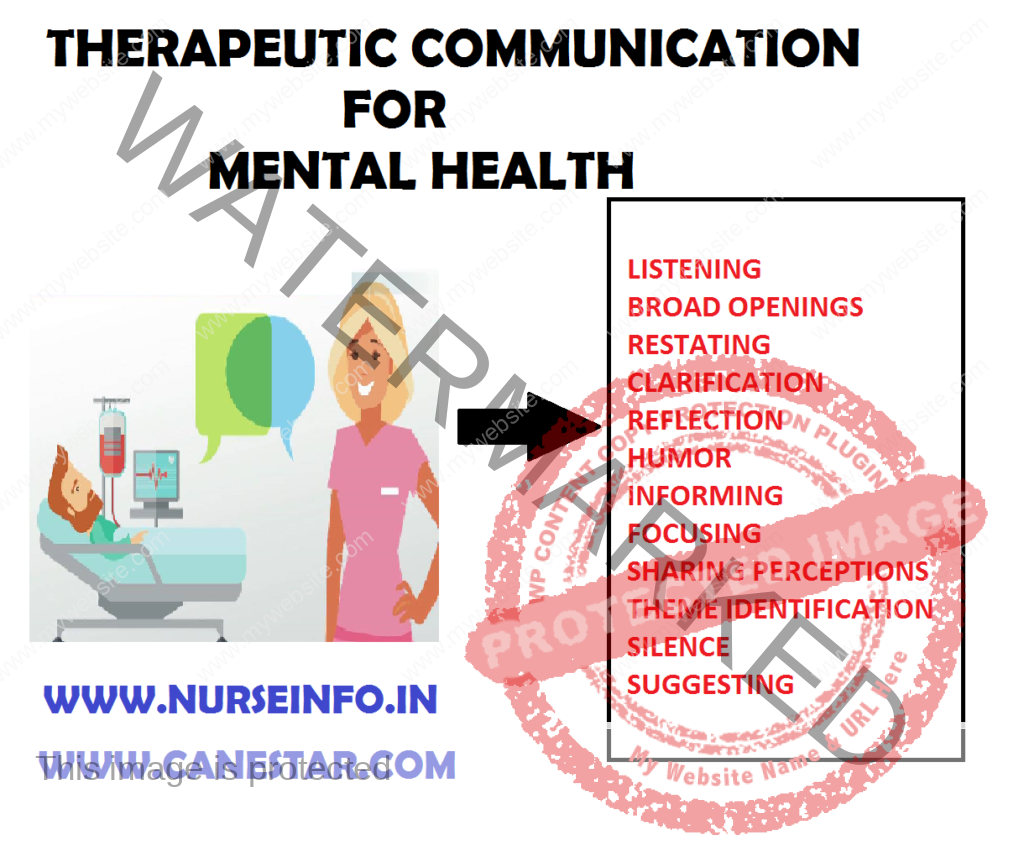THERAPEUTIC COMMUNICATION – Principles or Characteristics, Techniques and Non-therapeutic Communication
UPDATED 2024
Therapeutic communication is an interpersonal interaction between the nurse and the patient during which the nurse focuses on the patient’s specific needs to promote an effective exchange of information. All nurses need skills in therapeutic communication to effectively apply the nursing process and to meet standards of care for their patients.
Therapeutic communication can help nurses to accomplish many goals:
- Establish a therapeutic nurse-patient relationship
- Identify the most important patient’s needs
- Assess the patient’s perception of the problem
- Facilitate the patient’s expression of emotions
- Implement interventions designed to address the patient’s needs
To have an effective therapeutic communication, the nurse must consider privacy and respect of boundaries, use of touch and active listening and observation.
Principles or Characteristics of Therapeutic Communication
- The patient should be the primary focus of interaction
- A professional attitude sets the tone of the therapeutic relationship
- Use self-disclosure cautiously and only when it has a therapeutic purpose
- Avoid social relationship with patients
- Maintain patient confidentiality
- Assess the patient’s intellectual competence to determine the level of understanding
- Implement interventions from a theoretic base
- Maintain a nonjudgmental attitude. Avoid making judgments about patient’s behavior
- Avoid giving advice
- Guide the patient to reinterpret his or her experiences rationally.
Therapeutic Communication Techniques
- Listening: It is an active process of receiving information. Responses on the part of the nurse, such as maintaining eye-to-eye contact, nodding, gesturing and other forms of receptive nonverbal communication convey to the patient that he is being listened to and understood.
Therapeutic Value: Nonverbally communicates to the patient the nurse’s interest and acceptance.
- Broad Openings: Encouraging the patient to select topics for discussion. For example, “What are you thinking about?”
Therapeutic Value: Indicates acceptance by the nurse and the value of patient’s initiative.
- Restating: Repeating the main thought expressed by the patient. For example, “You say that your mother left you when you were 5-year-old”
Therapeutic Value: Indicated that the nurse is listening and validates, reinforces or calls attention to something important that has been said.
- Clarification: Attempting to put vague ideas or unclear thoughts of the patient into words to enhance the nurse’s understanding or asking the patient to explain what he means. For example, “I am not sure what you mean. Could you tell me about the again?”
Therapeutic Value: It helps to clarify feelings, ideas and perceptions of the patient and provides an explicit correlation between them and the patient’s actions.
- Reflection: Directing back the patient’s ideas, feelings, questions and content. For example, “You are feeling tense and anxious and it is related to a conversation you had with your husband last night”.
Therapeutic Value: Validates the nurse’s understanding of what the patient is saying and signifies empathy, interest and respect for the patient.
- Humor: The discharge of energy through comic enjoyment of the imperfect. For example, “That gives a whole new meaning to the word ‘nervous’”, said with shared kidding between the nurse and the patient.
Therapeutic Value: Can promote insight by making repressed material conscious, resolving paradoxes, tempering aggression and revealing new options, and is a socially acceptable for of sublimation.
- Informing: The skill of information giving. For example,” I think you need to know more about your medications.”
Therapeutic Value: Helpful in health teaching or patient education about relevant aspects of patient’s well-being and self-care.
- Focusing: Questions or statements that help the patient expand on a topic of importance. For example, “I think that we should talk more about your relationship with your father”.
Therapeutic Value: Allows the patient to discuss central issues and keeps the communication process goal-directed.
- Sharing Perceptions: Asking the patient to verify the nurses understanding of what the patient is thinking or feeling. For example, ”You are smiling, but I sense that you are really very angry with me”.
Therapeutic Value: Conveys the nurse understands to the patient and has the potential for clearing up confusing communication.
- Theme Identification: This involves identification of underlying issues or problems experienced by the patient that emerge repeatedly during the course of the nurse-patient relationship. For example, “I noticed that you said, you have been hurt or rejected by the man. Do you think this is an underlying issue?”
Therapeutic Value: It allows the nurse to promote the patient’s exploration and understanding of important problems.
- Silence: Lack of verbal communication for a therapeutic reason. For example, sitting with a patient and nonverbally communicating interest and involvement.
Therapeutic Value: Allows the patient time to think and gain insight, slows the pace of the interaction and encourages the patient to initiate conversation while enjoying the nurse’s support, understanding and acceptance.
- Suggesting: Presentation of alternative ideas for the patient’s consideration relative to problem solving. For example, “Have you thought about responding to your boss in a different way when he raises that issue with you? You could ask him if a specific problem has occurred.”
Therapeutic Value: Increases the patient’s perceived notions or choices.
Ineffective/Non-therapeutic Communication
These include failure to listen, conflicting verbal or non-verbal messages, a judgmental attitude, false reassurance, giving of advice, the inability to receive information because of a preoccupation of impaired thought process and changing of the subject if one becomes uncomfortable with the topic being discussed.

NURSING PROCEDURES LIST CLICK HERE

